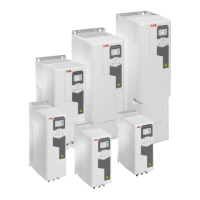224 Resistor braking
Resistor braking, frames R1…R3
Planning the braking system
Selecting the brake resistor
Frames R1…R3 have an built-in brake chopper as standard equipment. The brake
resistor is selected using the table and equations presented in this section.
1. Determine the required maximum braking power P
Rmax
for the application. P
Rmax
must be smaller than P
BRmax
given in the table on page 225 for the used drive
type.
2. Calculate resistance R with Equation 1.
3. Calculate energy E
Rpulse
with Equation 2.
4. Select the resistor so that the following conditions are met:
• The rated power of the resistor must be greater than or equal to P
Rmax
.
• Resistance R must be between R
min
and R
max
given in the table for the used
drive type.
• The resistor must be able to dissipate energy E
Rpulse
during the braking
cycle T.
Equations for selecting the resistor:
where
R = calculated brake resistor value (ohm). Make sure that: R
min
< R < R
mxx
.
P
Rmax
= maximum power during the braking cycle (W)
P
Rave
= average power during the braking cycle (W)
E
Rpulse
= energy conducted into the resistor during a single braking pulse (J)
t
on
= length of the braking pulse (s)
T = length of the braking cycle (s).
t
on
P
Rmax
P
Rave
T
Eq. 1.
450000
P
Rmax
U
N
= 400 V:
615000
P
Rmax
U
N
= 480 V: R =
P
Rmax
· E
Rpulse
=
t
on
Eq. 2.
P
Rmax
· P
Rave
=
t
on
T
Eq. 3. For conversion, use 1 hp = 746 W.
R =

